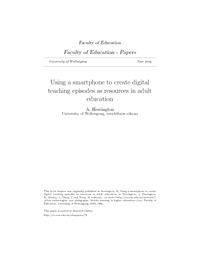Using a smartphone to create digital teaching episodes as resources in adult educationAnthony Herrington
|
 |
 Diese Seite wurde seit 5 Jahren inhaltlich nicht mehr aktualisiert.
Unter Umständen ist sie nicht mehr aktuell.
Diese Seite wurde seit 5 Jahren inhaltlich nicht mehr aktualisiert.
Unter Umständen ist sie nicht mehr aktuell.
 Zusammenfassungen
Zusammenfassungen
 While mobile technologies are not yet widely and routinely used in education, they have the potential to be used in a multitude of pedagogical and other contexts in higher education. For example, Patten, Sanchez and Tangney (2006) have identified several categories of use: • Administration, e.g., the use of calendars, exam reminders, grading software; • Referential, e.g., dictionaries, e-books and office applications; • Interactive, e.g., quizzes, response software; • Microworld, e.g., simulations, games; • Data collection, e.g., data logging, note taking, audio recording, eportfolios • Location aware, e.g., augmented environments, gps navigation and tagging; and • Collaborative, e.g., pod/vodcasting, blogging, instant messaging. The aims of this research were to evaluate the technological and pedagogical affordances of using a smartphone (combined mobile phone and personal digital assistant) as a data collection tool to create digital narratives or stories designed to be used by adult educators as curriculum resources in their teaching and training. In this study, video, pictures and audio were captured with a Palm Treo smartphone.
While mobile technologies are not yet widely and routinely used in education, they have the potential to be used in a multitude of pedagogical and other contexts in higher education. For example, Patten, Sanchez and Tangney (2006) have identified several categories of use: • Administration, e.g., the use of calendars, exam reminders, grading software; • Referential, e.g., dictionaries, e-books and office applications; • Interactive, e.g., quizzes, response software; • Microworld, e.g., simulations, games; • Data collection, e.g., data logging, note taking, audio recording, eportfolios • Location aware, e.g., augmented environments, gps navigation and tagging; and • Collaborative, e.g., pod/vodcasting, blogging, instant messaging. The aims of this research were to evaluate the technological and pedagogical affordances of using a smartphone (combined mobile phone and personal digital assistant) as a data collection tool to create digital narratives or stories designed to be used by adult educators as curriculum resources in their teaching and training. In this study, video, pictures and audio were captured with a Palm Treo smartphone. Dieser Text erwähnt ...
Dieser Text erwähnt ...
 Dieser Text erwähnt vermutlich nicht ...
Dieser Text erwähnt vermutlich nicht ... 
 Nicht erwähnte Begriffe | Handyverbot in der Schule, iPhone |
 Tagcloud
Tagcloud
 Volltext dieses Dokuments
Volltext dieses Dokuments
 |  Using a smartphone to create digital teaching episodes as resources in adult education: Artikel als Volltext ( Using a smartphone to create digital teaching episodes as resources in adult education: Artikel als Volltext ( : :  , 93 kByte; , 93 kByte;  : :  2021-03-21) 2021-03-21) |
 Anderswo suchen
Anderswo suchen 
 Beat und dieser Text
Beat und dieser Text
Beat hat Dieser Text während seiner Zeit am Institut für Medien und Schule (IMS) ins Biblionetz aufgenommen. Beat besitzt kein physisches, aber ein digitales Exemplar. Eine digitale Version ist auf dem Internet verfügbar (s.o.). Aufgrund der wenigen Einträge im Biblionetz scheint er es nicht wirklich gelesen zu haben. Es gibt bisher auch nur wenige Objekte im Biblionetz, die dieses Werk zitieren.









 Mobiltelefon
Mobiltelefon Biblionetz-History
Biblionetz-History